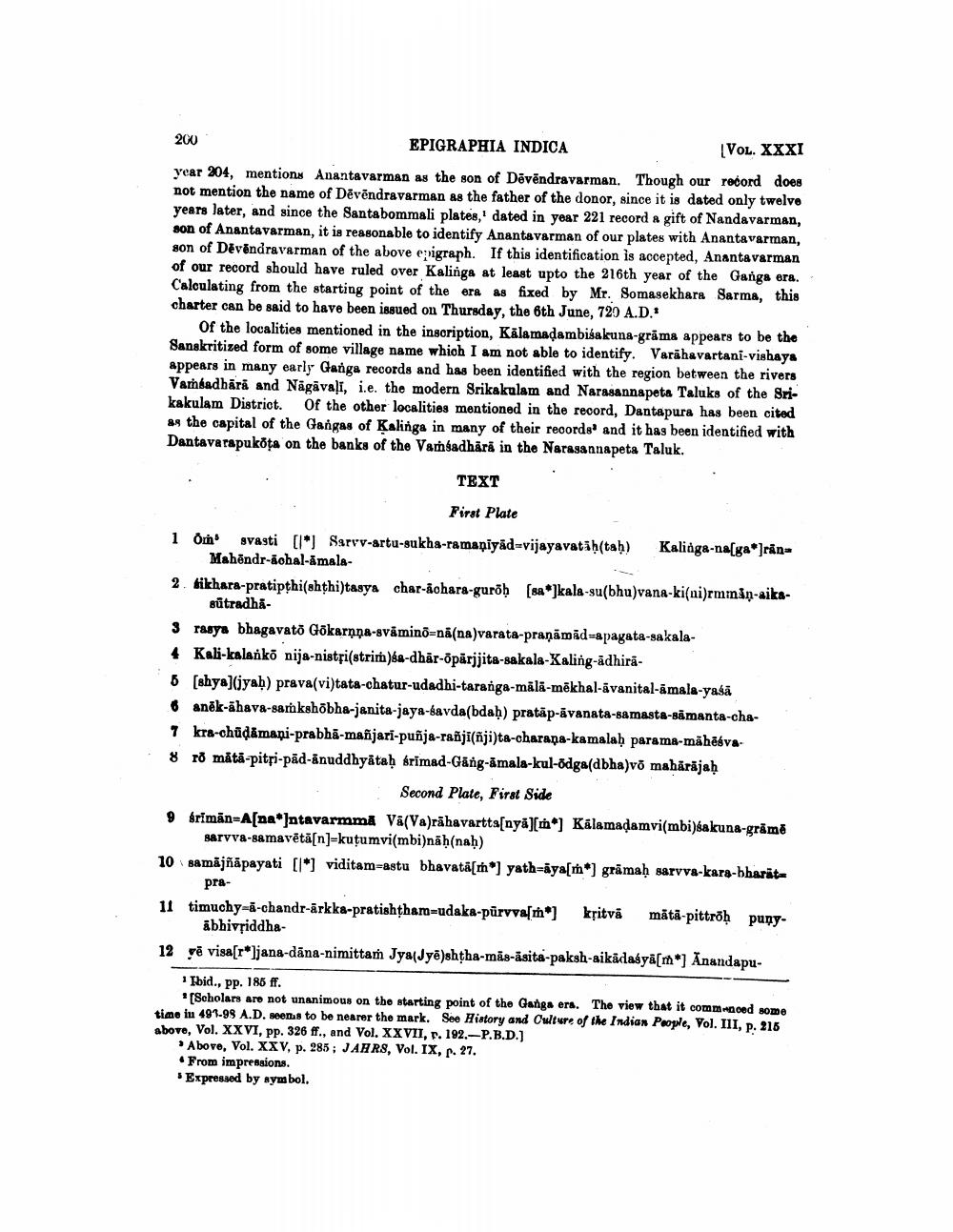________________
200
EPIGRAPHIA INDICA
(VOL. XXXI year 204, mentions Anantavarman as the son of Dēvēndravarman. Though our record does not mention the name of Dēvēndravarman as the father of the donor, since it is dated only twelve years later, and since the Santabommali plates,' dated in year 221 record a gift of Nandavarman, son of Anantavarman, it is reasonable to identify Anantavarman of our plates with Anantavarman, son of Dévēndravarman of the above epigraph. If this identification is accepted, Anantavarman of our record should have ruled over Kalinga at least upto the 216th year of the Ganga era. Calculating from the starting point of the era as fixed by Mr. Somasekhara Sarma, this charter can be said to have been issued on Thursday, the 6th June, 720 A.D.
Of the localities mentioned in the inscription, Kälamadambisakuna-grāms appears to be the Sanskritized form of some village name which I am not able to identify. Varahavartani-vishaya appears in many early Ganga records and has been identified with the region between the rivers Vambadhara and Nāgāvaļi, i.e. the modern Srikakulam and Narasannapeta Taluks of the Srikakulam District. Of the other localities mentioned in the record, Dantapura has been cited as the capital of the Gangas of Kalinga in many of their records and it has been identified with Dantavarapukota on the banks of the Vamgadhärä in the Narasannapeta Taluk.
TEXT
First Plate
1 Om svasti [l*] Sarvv-artu-sukha-ramaniyad=vijayavatäh(tah) Kalinga-na[ga*]rana
Mahēndr-ãohal-āmala2. tikhara-pratipthi(shthi)tasya char-kohara-guroh (sa*]kala-su(bhu)vana-ki(ni)rmmiņaiks
sutradha3 rasya bhagavato Gokarņņa-sväminā=nä(na)varata-praņāmād=apagata-sakala4 Kali-kalanko nija-nistri(strim)sa-dhār-õpärjjita-sakala-Kaling-adhira6 [shya)(yah) prava(vi)tata-chatur-udadhi-taranga-mālā-mēkhal-āvanital-amala-yaśā 6 anēk-āhava-samkshõbha-janita-jaya-savda(bdaḥ) pratāp-āvanata-samasta-samanta-cha7 kra-chūdāmaņi-prabhā-mañjari-puñja-rañji(ñji)ta-charana-kamalah parama-măhēsva8 18 måtā-pitsi-pād-anuddhyātaḥ srimad-Gang-amala-kul-8dga(dbha)vo mahārājaḥ
Second Plate, First Side 9 Srimān=A[na*]ntavarmmă Vâ(Va)rāhavarttasnya][m*) Kālamadamvi(mbi)sakuna-gräma
sarvva-samavētā[n]=kutumvi(mbi)näh(nah) 10 samājñāpayati [l*) viditam=astu bhavata[n) yath=aya[m*) grāmaḥ sarvva-kara-bharat
pra11 timuchy=ā-chandr-arkka-pratishtham=udaka-pūrvva[n) ksitvā mātā-pittroḥ puny
abhivriddha12 yē visa[r*ljana-dana-nimittam Jya(Jyē)shtha-mas-asita-paksh-aikādasyä[m*) Anandapu
Ibid., pp. 185 ff.
(Scholars are not unanimous on the starting point of the Ganga ers. The view that it commHgoed some time iu 491-99 A.D. seems to be nearer the mark. See History and Culture of the Indian People, Vol. III, p. 216 above, Vol. XXVI, pp. 326 ff., and Vol. XXVII, p. 192.-P.B.D.)
Above, Vol. XXV. p. 285; JAHRS, Vol. IX, p. 27. • From impressions. * Expressed by symbol.




